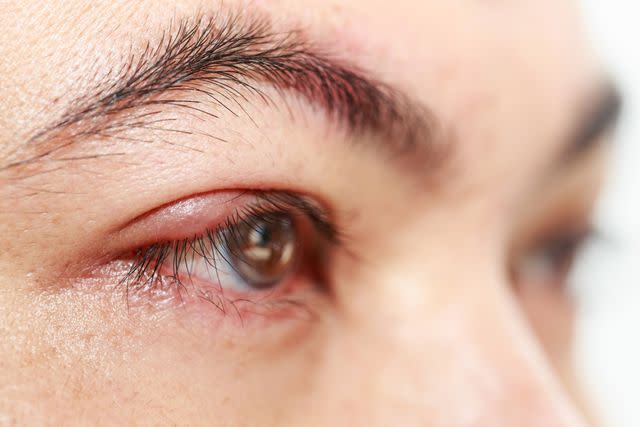What Are Blepharitis Symptoms?
Medically reviewed by Andrew Greenberg, MD
Blepharitis (eye inflammation) commonly causes your eyelids to become swollen, itchy and irritated. Sometimes confused with other eye conditions, blepharitis typically develops from too much bacteria on the skin and clogged oil glands around the eyelids.
While this uncomfortable condition isn’t curable, symptoms can be managed with home remedies or prescription medication.
This article provides an overview of blepharitis symptoms, offering tips on when to see a healthcare provider to treat irritation.

PhanuwatNandee / Getty Images
Blepharitis Symptoms: How to Tell
Your eyes are itchy, irritated, and maybe a little red. But how can you tell whether blepharitis or another eye condition is to blame? Blepharitis symptoms most commonly include:
Redness or discoloration around the eyelid area
Burning sensation
Tearing or watery eyes
Dry eyes
Crusting or stickiness around the eyelids
Blepharitis can also cause more serious problems like:
Vision issues like light sensitivity (photophobia) and blurry vision
Eyelashes that fall out or grow in the wrong direction
Swelling of the cornea
Types of Blepharitis
There are two types of blepharitis. Anterior blepharitis affects the outside of your eye. Typically, this is caused by bacteria, scalp dandruff, or mites. Posterior blepharitis affects the inner eyelid and eyeball and is usually caused by clogged oil glands, rosacea, or dandruff.
When you have blepharitis, you might notice your symptoms worsening in the morning after you wake up. These symptoms can come on gradually or show up fairly quickly.
Risks of Untreated Blepharitis Symptoms
Blepharitis is one of the most common eye conditions that healthcare providers treat.
While it is manageable, blepharitis can sometimes develop into more serious eye conditions if symptoms are left untreated. Some of the risks include:
Corneal ulcer (open sore on the eye's cornea)
Pink eye (conjunctivitis)
Stye (bacterial infection of a gland at the base of the eye)
Dry eye syndrome (tears are not able to provide enough lubrication)
Chalazion (a small, painless eyelid bump)
Other eyelid or eyelash issues
This is why keeping up with your healthcare provider’s recommended eyelid hygiene routine is important, even if you’re not experiencing a blepharitis flare-up.
Blepharitis Causes
Blepharitis can develop as a result of eyelid bacteria overgrowth, clogged oil glands, certain skin conditions, eyelash mites, or poor hygiene.
Treatment: How to Get Rid of Blepharitis Symptoms
Blepharitis symptoms can be long-lasting and flare up frequently if not correctly managed. Fortunately, some treatments can help ease blepharitis symptoms and inflammation. These options involve a mix of home remedies and over-the-counter (OTC) or prescription medications, as needed.
Home Remedies
To help control blepharitis symptoms, eye experts typically recommend a thorough eyelid cleaning plan/hygiene. This involves at-home eyelid skin care steps such as:
Applying warm compresses around the eye area
Lightly massaging the eyelids
Safely clearing away any built-up debris with a gentle eyelid scrub
In addition, there are some other complementary treatment options that your healthcare provider might recommend. Some of these might include the following:
Omega-3 fatty acid supplementation: May help reduce inflammation and dry eye symptoms
Tea tree oil application: May help eyelash mites (Demodex) infestation when applied to the eyelid area
Intense pulse light therapy (IPL) treatments: Might benefit dry eye symptoms in people who use this option for another skin condition like rosacea
Medications
Some blepharitis cases will also require medications to help ease symptoms. This includes OTC medicated eyelid washes or wipes that help keep the area clean and prevent additional inflammation. Available options include:
Avenova, a wash made from hypochlorous acid
Cliradex, a medicated wipe made of tea tree oil
Blephadex, a medicated wipe specifically for blepharitis that develops from eyelash mites
Xdemvy (lotilaner) is an antiparasitic eye drop used to treat Demodex blepharitis
Certain types of blepharitis or more severe cases may require prescription medication, which your healthcare provider will determine during your diagnosis. This might include the following to help relieve symptoms, clear bacteria, and reduce inflammation:
Topical antibiotics in the form of ointment applied to the eye
Oral antibiotics taken in a short course
Topical steroids in the form of eye drops
Lubricating eye drops as needed (to keep the eye moist)
Signs of Worsening Blepharitis Symptoms
While blepharitis can often ease up on its own—or go through periods where symptoms are not flaring—many times, treatment is required.
If you've been following the at-home eyelid care regularly, but symptoms don't seem to improve, flagging this to a healthcare provider is a good idea. From there, they can perform an eye exam and recommend another treatment option.
In addition, sometimes blepharitis can be mistaken for other common eye conditions, such as:
Bacterial infections like impetigo (skin infection that causes sores and blister-like bumps)
Viral infections like varicella-zoster virus (the virus that causes chickenpox)
Parasitic infections
Skin conditions like psoriasis
Noncancerous or cancerous eyelid tumors
Chemical trauma
Takeaway
Any changes to your vision, which can sometimes happen with blepharitis, that last more than a few days or start to get worse should be checked out by a healthcare provider as soon as possible.
Summary
Blepharitis is a common eye condition that typically causes dry, irritated, inflamed, and red eyelids—and sometimes other symptoms like a burning sensation, eye tearing, or vision changes. While blepharitis has no cure, treatment options like home remedies and medications are available to help ease discomfort.
Read the original article on Verywell Health.

